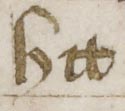|
| A |
 | Usage: made
lower case 'a' varies according to the folios consulted. It always appears as a double compartment graph but is sometimes a true anglicana 'a' and at others a straight-sided 'a' with horizontal cross-bar and various different shapes for the upper compartment. Here 'a' has an angled head-stroke. |  | Usage: and
in this version the head is closed with a diagonal hairline stroke. |
 | Usage: As
'A's may be angular or more rounded as in version 4. |  | Usage: And |
|
| D |
 | Usage: darte
unlooped 'd' is used most of the time. |  | Usage: wold
the scribe does use looped 'd' occasionally, here in final position. |
 | Usage: deseruyd
the scribe uses what appears to be an upper case letter in initial position. |  | Usage: dede
both forms of the 'd' graph in this word. |
|
| G |
 | Usage: greue
tailed 'g' is used throughout. At the beginning of the manuscript the tails of 'g' are generally short and neat, extending no further in a clockwise direction than the extent of the graph. |  | Usage: knowlychinge
further on in the manuscript the tails of 'g' may extend clockwise in sweeping curves beneath previous graphs. |
 | Usage: right |  | Usage: Genio
upper case 'G' in the rubric in the hand of the scribe. |
|
| H |
 | Usage: haue
the scribe usually copies well above the line. The limb of 'h' therefore descends in a gentle curve and ends at the line. |  | Usage: suche
the head of 'h' may be looped or open as in version 1. |
 | Usage: ryghte
'h' following 'g' is crossed. The tail extends well below the line. |  | Usage: Hit
upper case 'H' with thick, straight stem and open head-stroke. |
|
| R |
 | Usage: ryght
modern 'r' is used throughout in all positions. |  | Usage: Vnwar |
 | Usage: or
'z'-shaped 'r' is used after 'o'. |  | Usage: Right |
|
| S |
 | Usage: synge
long 's' is used in initial and medial positions. The stem may be very thick as in this example. |  | Usage: goddes
kidney-shaped 's' with horn is used in final position. |
 | Usage: syknesse
long 's' used medially. |  | Usage: Scheo |
|
| W |
 | Usage: was
'w' is formed as two 'v's. There is a single lobe to the right. |  | Usage: owt |
 | Usage: wt
used frequently |  | Usage: Where
the upper case graph is slightly more elaborate with left limb extended to the left and a 'B'-shaped element to the right. |
|
| Y |
 | Usage: ys
the fork of 'y' usually appears at or above the line. |  | Usage: betyde
the tail-stroke is usually fine and straight with no return. |
 | Usage: lye |  | Usage: lyuynge |
|
| Thorn |
 | Usage: oþer
the stem of thorn is long and tapering. |  | Usage: neuyrþeles
the lobe of thorn is attached to the top of the stem. |
 | Usage: bryngeþ |  | Usage: doþ |
|
| Upper Case A |
 | Usage: And
upper case 'A's in all their variety. |  | Usage: As |
 | Usage: As |  | Usage: And
it is interesting that so many scribes seemed to delight in varying the 'A' graphs. |
|
| Upper Case Letters |
 | Usage: I |  | Usage: Beholde |
 | Usage: But |  | Usage: To |














































